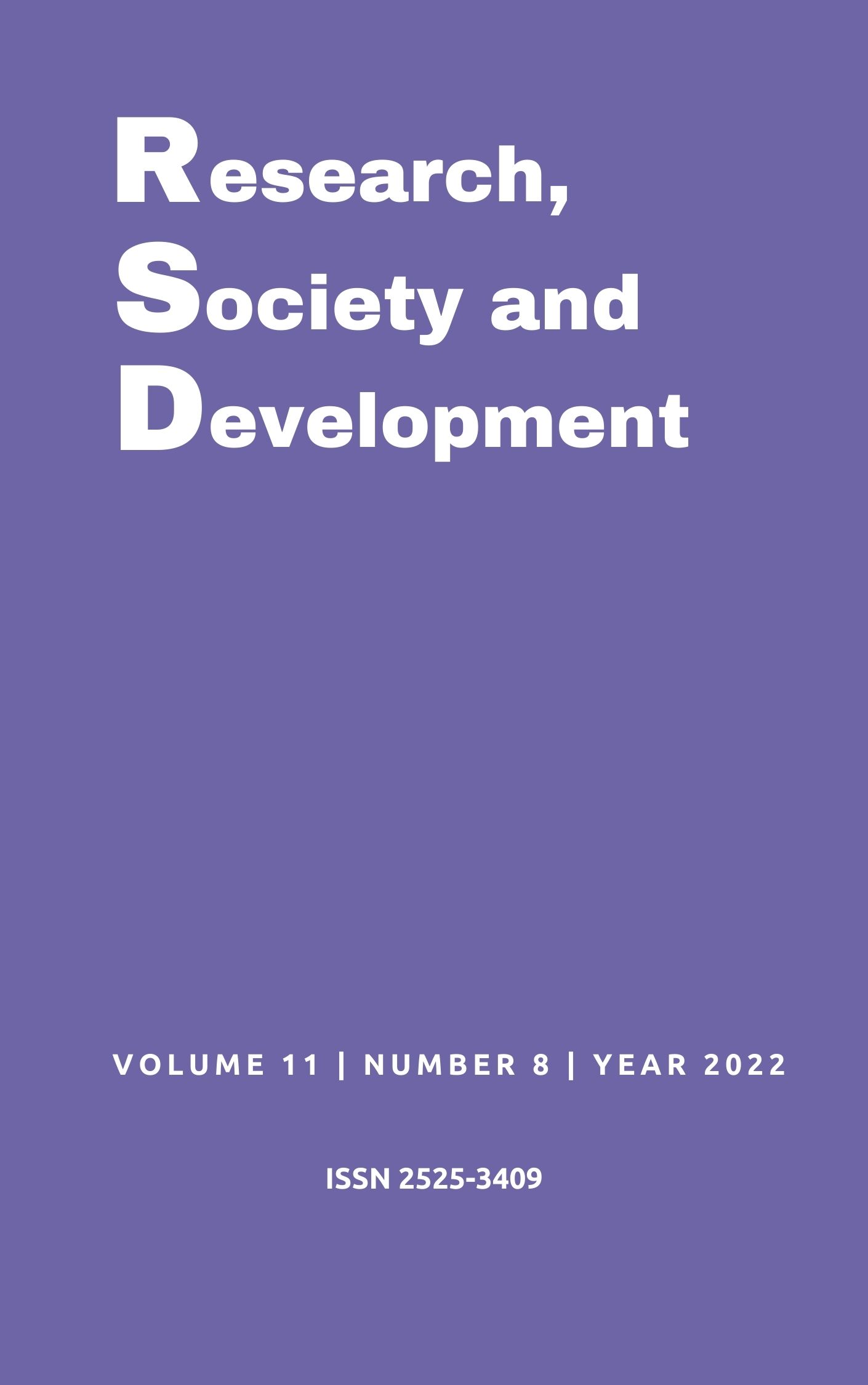Analysis of the scientific production on Down Syndrome
DOI:
https://doi.org/10.33448/rsd-v11i8.31337Keywords:
Down Syndrome; Nursing; Family Health Strategy; Primary Health Care; Family.Abstract
Introduction: The object of this study is to understand the scientific production on Down Syndrome (DS) in Nursing journals. Down Syndrome is a genetic condition that causes chromosome alterations and was discovered by the English physician John Langdon Down, who named it trisomy 21. Objective: to analyze the scientific production on Down Syndrome in the period 2011-2022 in Brazil. Method: This is an integrative literature review based on scientific articles about this condition, published in Brazilian nursing journals with QUALIS A1 to B3, covering primary and secondary data research. Seven scientific articles were selected and analyzed. Resultados/Discussão: 2013 was the year with the highest number of publications about this syndrome, as for the title of the authors in the articles, most had the participation of masters, doctors and teachers. Regarding the federative state, most were concentrated in the Northeast region, with qualitative approach most. The main difficulty reported in the articles by professionals was the management with this diagnosis in relation to the family and client. Conclusion: There are few articles published in the nursing field about Down Syndrome, a fact evidenced by the low production over 10 years of publication in journals. The production of new scientific works is proposed, since they are fundamental for professionals to update themselves with new knowledge, as well as to be led to an assistance that aims at the perspective of the family together with the patient regarding his future and the importance of the multidisciplinary team's performance in the development of children with Down Syndrome.
References
Barbosa, J. O., Jesus, A. C. P., & Santos, F. S. (2013). Síndrome de down: dificuldades em transmitir o diagnóstico. Rev. de Enfermagem UFPE On Line. 7(7): 4726-31. https://doi.org/10.5205/1981-8963-v7i7a11724p4726-4731-2013.
Barros, D. R., Vieira, R. O., Viana, D. N. M., & Cordeiro, D. S. S. C. (2019). O impacto do diagnóstico da síndrome de down no núcleofamiliar: uma perspectiva psicológica. Temas em Saúde, Faculdade Integrada de Patos, 275 a 302. https://temasemsaude.com/wp-content/uploads/2019/03/fippsi16.pdf.
Brasil. (2013). Ministério da Saúde. Secretaria de Atenção à Saúde. Departamento de Ações Programáticas Estratégicas. Diretrizes de atenção à pessoa com Síndrome de Down. Ed. 1 Brasília. pt 1-60. https://bvsms.saude.gov.br/bvs/publicacoes/diretrizes_atencao_pessoa_sindrome_down.pdf.
Brasil. (2020). Sociedade Brasileira de Pediatria. Departamento Científico de Genética. Diretrizes De Atenção À Saúde De Pessoas Com Síndrome De Down. pt: 2-25. https://bvsms.saude.gov.br/bvs/publicacoes/diretrizes_atencao_pessoa_sindrome_down.pdf.
Coelho, C. (2016). A síndrome de Down. Psicologia. pt, 1-14. https://www.psicologia.pt/artigos/textos/A0963.pdf.
Gayan, L. A., Saura, N. D., & Nassarre, P. P. (2019). Cuidados de Enfermería en las personas con Síndrome de Down. Fundación para el Desarrollo de la Enfermería, 1 ed. Madrid, 5- 126. https://www.sindromedown.net/wp-content/uploads/2019/06/Sindrome_Down_Libro_Logo.pdf
Henn, C. G. (2007). O envolvimento paterno e a experiência da paternidade no contexto da síndrome de down,1-98. https://www.lume.ufrgs.br/bitstream/handle/10183/11248/000610840.pdf?sequence=1.
Kortchmar, E., Jesus, M. C. P. D., & Merighi, M. A. B. (2014). Vivência da mulher com um filho com síndrome de down em idade escolar. Texto & Contexto-Enfermagem, 23, 13-20. https://doi.org/10.1590/S0104-07072014000100002.
Lucisano, R. V., Pfeifer, L. I., Pinto, M. P. P., Santos, J. L. F., & Anhão, P. P. G. (2013). Interações sociais de crianças pré-escolares com Síndrome de Down durante atividades extracurriculares. Revista Brasileira de Enfermagem, 66, 116-122.https://doi.org/10.1590/S0034-71672013000100018.
MATA, C. S., & Pignata, M. I. B. (2014). Síndrome de Down: Aspectos Históricos, Biológicos e Sociais 1-14.https://files.cercomp.ufg.br/weby/up/80/o/TCEM2014-Biologia-CeciliaSilvaMAta.pdf
Nunes, M. D. R., & Dupas, G. (2011). Independencia del niño con Síndrome de Down: la experiencia de la familia. Revista Latino-Americana de Enfermagem, 19(4), 985-993.https://doi.org/10.1590/S0104-11692011000400018
Schettini, DLC, Riper, MLV, & Duarte, ED (2021). Apreciação familiar acerca do diagnóstico de síndrome de Down. Texto & Contexto-Enfermagem, 29. https://doi.org/10.1590/1980-265X-TCE-2019-0188
Souza, M. T. D., Silva, M. D. D., & Carvalho, R. D. (2010). Revisão integrativa: o que é e como fazer. Einstein (São Paulo), 8, 102-106. https://www.scielo.br/j/eins/a/ZQTBkVJZqcWrTT34cXLjtBx/abstract/?lang=pt
Tavares, J. S., Guimarães, K. S. D. L., & Rodrigues, W. F. G. (2017). Atenção à saúde mental de pacientes com síndrome de down: Relato de experiência. Rev. enferm. UFPE on line, 2238-2241. https://doi.org/10.5205/1981-8963-v11i5a23381p2238-2241-2017
Torquato, I. M. B., De Araujo Dantas, M. S., De Oliveira, S. M. D., De Assis, W. D., Santos Fechinne, C. P. N. D., & Collet, N. (2013). Participação paterna no cuidado à criança com síndrome de Down. Journal of Nursing UFPE/Revista de Enfermagem UFPE, 7(1). https://doi.org/10.5205/1981-8963-v7i1a10200p30-38-2013.
Trentin, F. E., & dos Santos, V. L. P. (2013). Aspectos gerais da síndrome de Down: Ama visão biológica. Cadernos da Escola de Saúde, 1(9). https://portaldeperiodicos.unibrasil.com.br/index.php/cadernossaude/article/view/2371/1943.
Downloads
Published
How to Cite
Issue
Section
License
Copyright (c) 2022 Aretha Maria Alves Tenório de Oliveira; Estephane Layanne Santos da Silva; Uirassú Tupinambá Silva de Lima; Maria da Glória Freitas; Maria José Ribeiro Silva

This work is licensed under a Creative Commons Attribution 4.0 International License.
Authors who publish with this journal agree to the following terms:
1) Authors retain copyright and grant the journal right of first publication with the work simultaneously licensed under a Creative Commons Attribution License that allows others to share the work with an acknowledgement of the work's authorship and initial publication in this journal.
2) Authors are able to enter into separate, additional contractual arrangements for the non-exclusive distribution of the journal's published version of the work (e.g., post it to an institutional repository or publish it in a book), with an acknowledgement of its initial publication in this journal.
3) Authors are permitted and encouraged to post their work online (e.g., in institutional repositories or on their website) prior to and during the submission process, as it can lead to productive exchanges, as well as earlier and greater citation of published work.

